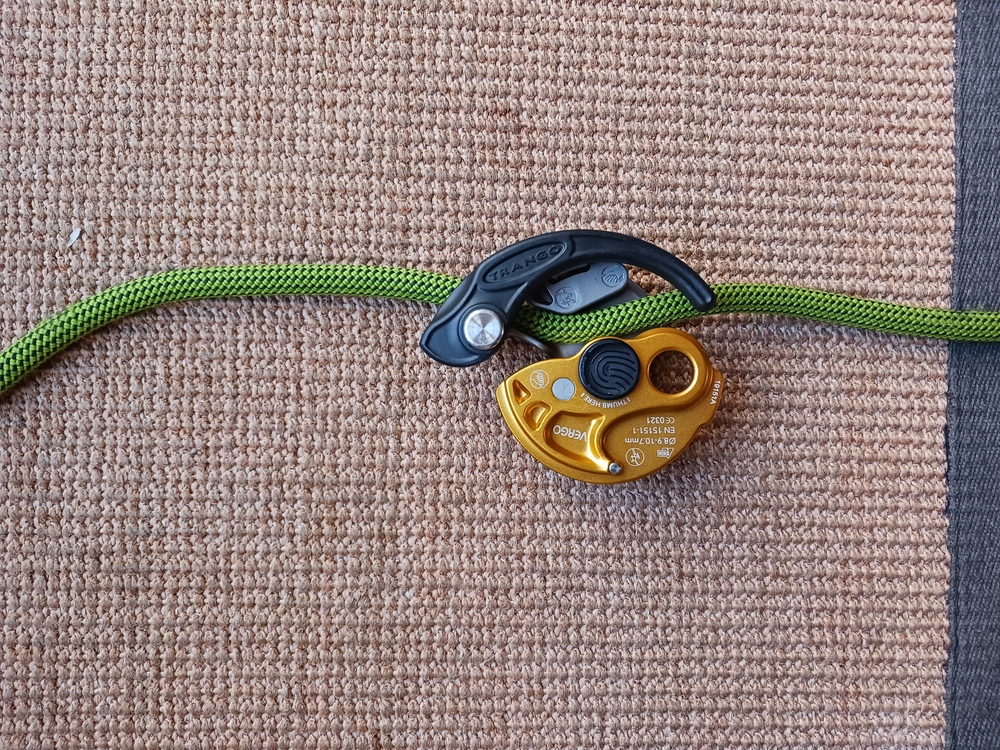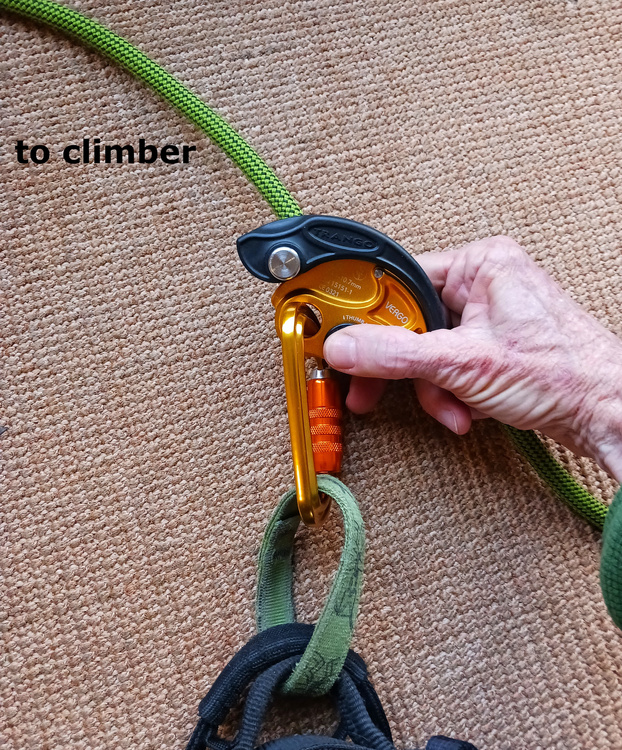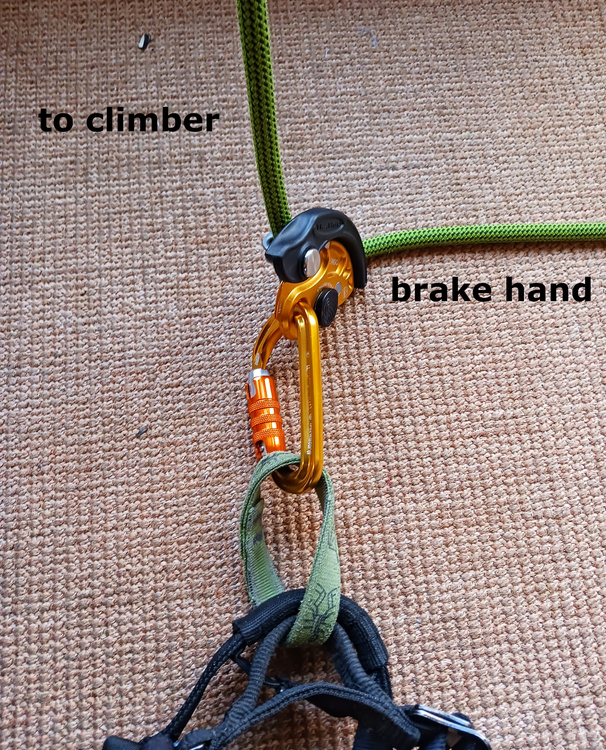Trango Vergo - the GriGri slayer?
|
|
|
|
|
Gregger Man wrote: "Respect how the device works"... Exactly. Thanks for the video and that phrase. |
|
|
The grigri can fail in the exact same way the vergo allegedly failed above. https://www.mountainproject.com/forum/topic/109869225/another-accident-due-to-mis-use-of-the-gri-gri That said, it's not grigris or vergos or whatever devices that scare me. It's zealous supporters of their chosen mechanical device who forget the importance of proper belay technique, to include ALWAYS maintaining a hand on the brake and whatever other peculiarities their device requires. |
|
|
Don Frijoles wrote: Fan Y literally outlines an example of blatant user error (and horrible belaying technique). Mark D himself said that, while he can’t pinpoint the cause of the minor slippage in his case, he can’t rule out user error. If you can provide some kind of experimental evidence versus anecdotes then I would change my tune, but I’ve yet to see any empirical evidence that the trango is more dangerous except for the fact that, being that it requires an unfamiliar belay technique and loading orientation, it’s more prone to user error. |
|
|
Don Frijoles wrote: And apparently you don't have to look very far to find exactly those kinds of people... lol. |
|
|
Don Frijoles wrote: Waiting on some actual, non anecdotal evidence. Should be easy enough since it’s such a dangerous device.
|
|
|
Don Frijoles wrote: I am going to venture a guess that it is due to the fact that the device is being operated in completely different manner from GriGri style devices - I am including Lifeguard, Birdie, etc. It is being loaded differently, held differently, slack fed differently. |
|
|
Matthew Jaggers wrote: Like fucking clockwork |
|
|
Rasputin NLN wrote: “The device you use is garbage”
|
|
|
Except rappelling is inherently 'unsafe' because all safety features (i.e. stopper knots/closed loop) are constructed by the climber at the time of rappel and de/reconsructed between every rappel, whereas the safety features in a given belay device are built in and proper use simply requires initial education... like any piece of new equipment. Mark D. is doing something called 'conjecture' and those agreeing with him are doing so based on incomplete information. There's no real reason to believe that the hand-to-hip position is the cause of the slippage. |
|
|
Since the device hinges as it moves forward/outward/upward from the belay loop, I can see how a belay grip around the right hip + a left hip pointed towards the first bolt could inhibit or delay some rotation. I think the left/right orientation has a real effect: it locks up much easier if I turn my right side towards the first bolt. Turning the left hip towards the climb makes a straight path with the minimum drag on that pin- wrapping the brake hand around the hip would just keep the device close to the belay loop while the rope slides thru. If your hand were close enough to hit the device and lift it, it would likely move enough to engage the pin. The conjecture might have some merit. (someone should try to reproduce that scenario with a backup belay) |
|
|
Gregger Man wrote: Testing of this in a controlled setting would be nice; I can see body orientation potentially having an effect on the ability of the device to bite (bear in mind: the GriGri also has niche weak points like this, too). That said, I haven't found hand-to-hip vs hand-straight-down to really change the orientation of the vergo in the braking position to a noticeable degree. |
|
|
Don Frijoles wrote: Do you understand what "assisted" mean in "assisted braking device"? Does your rope self-tie stoppers when you go to rappel (pigtails don't count)? Does a third hand appear from thin air as you kick off the wall? No. The climber has to create all these backups at the time of the rappel, and every time the climber has to remake thse safeties introduces room for error. This is why rappelling is 'unsafe' (compared to lowering).
You are assigning a lot of credibility to internet anecdotes. Maybe I should dig up some examples of GriGri failures in the hands of experienced climbers. In fact, I know of one right off the top of my head https://youtu.be/wz1PTbjQ3pc?t=250 And people use this death trap?!? YGDDDDDDDD |
|
|
J E wrote: If you don’t hold the brake strand, the climber might die (because the grigri still caught the climber in the majority of this manufactured scenario) is evidence of a “death trap”? Wow, imagine, like, using a tube style device. OMG!!! |
|
|
Colonel Mustard wrote: I linked the wrong video. I was referring to the angle of the climber side affecting the bite power on the grigr
|
|
|
J E wrote: The video is worth watching and thinking about, but it shows that a GriGri may fail if the belayer does not hold the brake strand and some other conditions are present--thin/slippery rope and, interestingly, the belayer redirecting the rope to reduce the friction that would be present if the belayer truly went "hands free," i.e. was not touching the rope. It is not an example of a Grigri failing by someone who even purported to be using the device correctly. That seems different from reports of Vergo and Cinch failures, where the users say (rightly or wrongly) that they were using the device correctly but it failed nonetheless. I don't have any opinion on Vergo/Cinch (other than noting there are a number of troubling reports of belay failures, going back a number of years) but I think it's notable how few reports of belay failures involving GriGris there are where the user even claims (again, rightly or wrongly) that he/she was using the device correctly. I suppose the same thing could be said of an ATC and the like--the device itself never fails. But humans are also "devices" of sorts and we fail from time to time--and if the human device "fails" for whatever reason, I'd rather be on an unassisted GriGri than an unassisted ATC. A question is what combination of belay device and human is most likely to give a safe and user-friendly belay--for me the GriGri works great, but I imagine other devices can work very well too. |
|
|
TLDR: Ive learned the vergo is more sensitive than I thought wrt to your thumb placement. Makes perfect sense now that I've learned it. I think the device is safe to use, but requires more expertise than I realized and I'm going to use something else. Both for my partner and my comfort. So I made my post for two reasons. One was a PSA that I had a scary experience and I suspected it was my fault. I’m glad I learned the failure mechanism and I hope that will help others to be sensitive to this with the device. The other was for a self imposed public shaming since I just felt so crappy at the time. My strict shame based religious upbringing demanded some sort of additional toll before I could move on. I’ve played around with the device some more and I agree that if my thumb had been on the pad (pivot point) this wouldn’t have happened. It catches super well. So my take away is this. I get why people love this device. it is a smooth belaying experience and a real joy to use when used correctly. However the margin for incorrect use is much tighter than i realized. if you and your climber are comfortable with that and really understand the sensitivity of the device then i think it is a fine device. I hope the big takeaway for everyone reading this is just how small the margin is on where you place your thumb for correct use of this device I didn't realize that before and that is my fault for not being more vigilant in understanding my device. That said it seems like im not alone here so i hope this helps others Personally, I'm going to stick with other devices. I'm usually a learn from your mistakes and don't let them ruin the future kind of person. however, i also lower off sport climbs even though im confident i know how to rappel because why expose myself to risk i dont need to take? In my case I'm a trad dad right now who doesn't get to climb as much as I'd like. I see no reason to use a device that gives me a little easier feed with the caveat of additional sensitivity for the miles im putting in as a belayer. I doubt my partner would ever want me to use the device again and i don't blame him. That takes it off the table for me. I think that needs to be a part of this discussion too. Your competence AND the leaders confidence in your belay are both required for successful, safe and fun climbing. I'm using the revo for now and I'll probably look into the gigajul at some point. I prefer tube style belay devices anyways. |
|
|
Anyone have a Cinch they want to sell? |
|
|
One other thought on the grigri vs Vergo topic. A lot more people are aware of what incorrect grigri use looks like. That breeds exponential better use since more people learn the right way to use the device. Hopefully this thread and others will help spread the knowledge. When I had my near drop a gym employee was right by me and commented in the post lower discussion between me an my partner that he thought my hand wasn’t in “break mode”. Turns out he was right in that something with my brake hand was wrong but his analysis of what was wrong was off. If I’d been gorilla gripping a grigri I’m certain he could have given me proper instruction on the spot. |
|
|
I’d like to add a bit more info re the Vergo and how it works. This is based on my experience and observations of the device:
The major drawback that I’ve experienced with the Vergo when belaying is, if you move your hand away from your body/belay loop, it causes the two halves to pivot in relation to each other and lock on the rope. You WILL short rope the leader - guaranteed! However, with awareness and some practice it’s not an issue. From my experience, the major failure point is the same as most any belay device: grabbing the rope above the device or holding the device in a wrong manner. I’ve also used the Vergo for TR Solo for a number of years (always with a Microtrax or RollnLock backup) and have never had an issue with it locking. This is somewhat equivalent to belaying with no-hands, though different in that there is the weight of the free rope below the climber. YMMV |

 Continue with onX Maps
Continue with onX Maps Sign in with Facebook
Sign in with Facebook


























